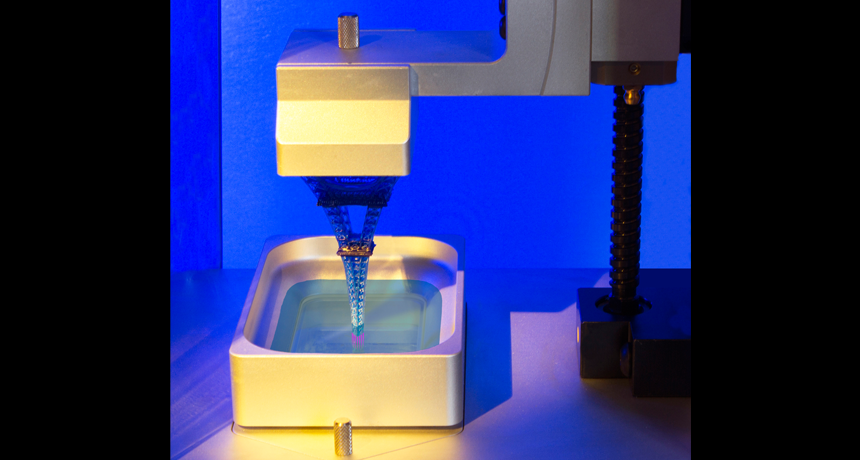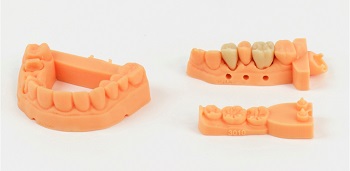Goopy tech leaves older 3-D printing in its wake
Speedy process creates objects using oxygen, ultraviolet light and liquid resin

A little Eiffel Tower rises from goopy resin in just one hour, thanks to a new 3-D printing method that manipulates ultraviolet light and oxygen to create detailed objects.
Lars Sahl
Share this:
- Share via email (Opens in new window) Email
- Click to share on Facebook (Opens in new window) Facebook
- Click to share on X (Opens in new window) X
- Click to share on Pinterest (Opens in new window) Pinterest
- Click to share on Reddit (Opens in new window) Reddit
- Share to Google Classroom (Opens in new window) Google Classroom
- Click to print (Opens in new window) Print
By Beth Mole
A movie robot made of liquid metal that could take on any shape has inspired researchers to print three-dimensional objects from a puddle of goo.
The new 3-D printing method manipulates ultraviolet (UV) light and oxygen to fuse liquid resin into solid objects. Those objects rise out of a shallow basin of resin in just minutes. That is far less time than required with conventional 3-D printers. The new process is also more precise. Printers that use this technology could be used to make anything from aircraft parts to medical devices.
The system’s designers shared details of their new technology online March 16 in Science.
Inspiration for the printer came from the 1991 movie Terminator 2: Judgment Day. In the film, a robotic villain made of liquid metal assumes different shapes. Instead of metal, Joseph DeSimone and his colleagues chose to work with goopy resins. DeSimone is a polymer chemist at the University of North Carolina at Chapel Hill.
Polymers are substances whose molecules are made from long chains of repeating groups of atoms. In this new printer, liquid resin forms a hard polymer, a plastic, when zapped with UV light. Oxygen helps control the process by keeping some areas of the resin liquid at all times.

Older 3-D printers work with “inks” made of plastic, metal, ceramic or other materials, even food and cells. Those printers lay down their ink, layer by layer. Eventually a solid object emerges. One problem with that approach is speed, DeSimone says. “I know of mushrooms that grow faster than 3-D printers print,” he says.
In their new approach, DeSimone and his colleagues filled a chamber with resin. A window at the bottom allows UV light and oxygen to pass through into the resin above. The oxygen penetrates only a short distance. Since oxygen prevents polymers from forming, the researchers call this oxygen-rich area a “dead zone.” Meanwhile, the UV light can travel deeper into the resin, past that dead zone.
The printer works when a metal plate is lowered into that sweet spot, one reachable only by the UV light. To print a 3-D object, the system projects a stream of UV light patterns. These patterns represent the template of the object to be printed. The light causes the polymers to start linking up on the metal plate. Gradually and steadily, the plate rises. As it does, more resin enters the sweet spot. More solidifies onto the bottom of the object. In short order, the desired object grows and takes shape.
3-D GOO GAME A new printing method can draw 3-D objects with a dunk in a liquid resin pool. Carbon3D, Inc. |
Watching the printer at work recalls the T-1000 robot from Terminator 2: a solid, detailed object rising from a shallow puddle of ooze. The researchers have used the printer to create complex structures. These include a detailed model of the Eiffel Tower.
Materials engineer Joshua Pearce of Michigan Technological University in Houghton calls the printer’s mix of speed and precision “really impressive.”
Sales of the printers using the new 3-D technology could start this year.
Power Words
(for more about Power Words, click here)
atom The basic unit of a chemical element. Atoms are made up of a dense nucleus that contains positively charged protons and neutrally charged neutrons. The nucleus is orbited by a cloud of negatively charged electrons.
chemistry The field of science that deals with the composition, structure and properties of substances and how they interact with one another. Chemists use this knowledge to study unfamiliar substances, to reproduce large quantities of useful substances or to design and create new and useful substances. (about compounds) The term is used to refer to the recipe of a compound, the way it’s produced or some of its properties.
molecule An electrically neutral group of atoms that represents the smallest possible amount of a chemical compound. Molecules can be made of single types of atoms or of different types. For example, the oxygen in the air is made of two oxygen atoms (O2), but water is made of two hydrogen atoms and one oxygen atom (H2O).
oxygen A gas that makes up about 21 percent of the atmosphere. All animals and many microorganisms need oxygen to fuel their metabolism.
polymer Substances whose molecules are made of long chains of repeating groups of atoms. Manufactured polymers include nylon, polyvinyl chloride (better known as PVC) and many types of plastics. Natural polymers include rubber, silk and cellulose (found in plants and used to make paper, for example).
resin A sticky, sometimes aromatic substance, often secreted by plants. It may also be the viscous starting ingredient for some plastics that will harden when heated or treated with light.
robot A machine that can sense its environment, process information and respond with specific actions. Some robots can act without any human input, while others are guided by a human.
three-dimensional (3-D) printer A machine that takes instructions from a computer program on where to place some raw material to create a three-dimensional object.
three-dimensional (3-D) printing The creation of a three-dimensional object with a machine that follows instructions from a computer program. The computer tells the printer where to lay down some raw material, which can be plastic, metals, food or even living cells. 3-D printing is also called additive manufacturing.
ultraviolet (UV) A portion of the light spectrum that is close to violet but invisible to the human eye.







